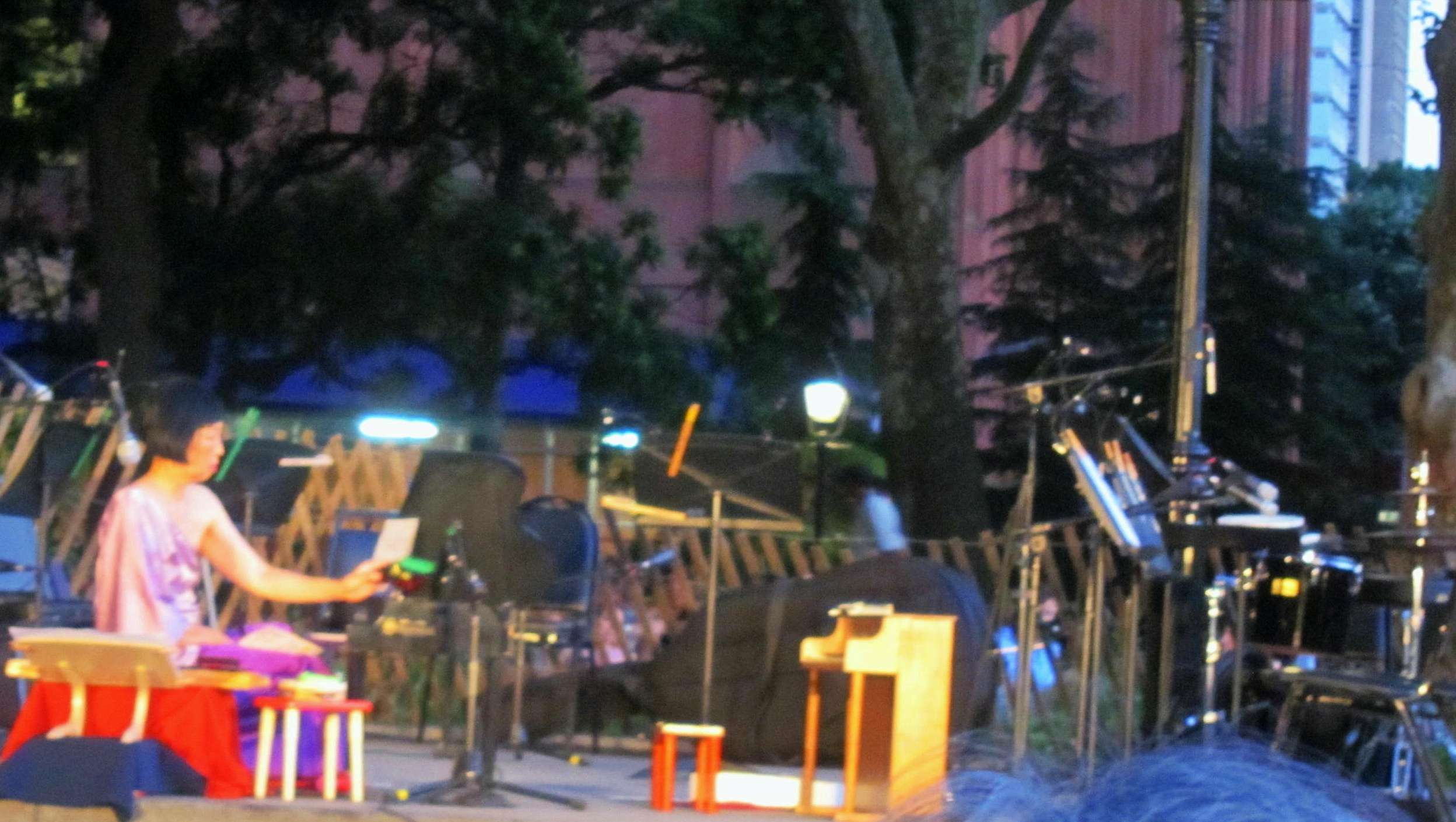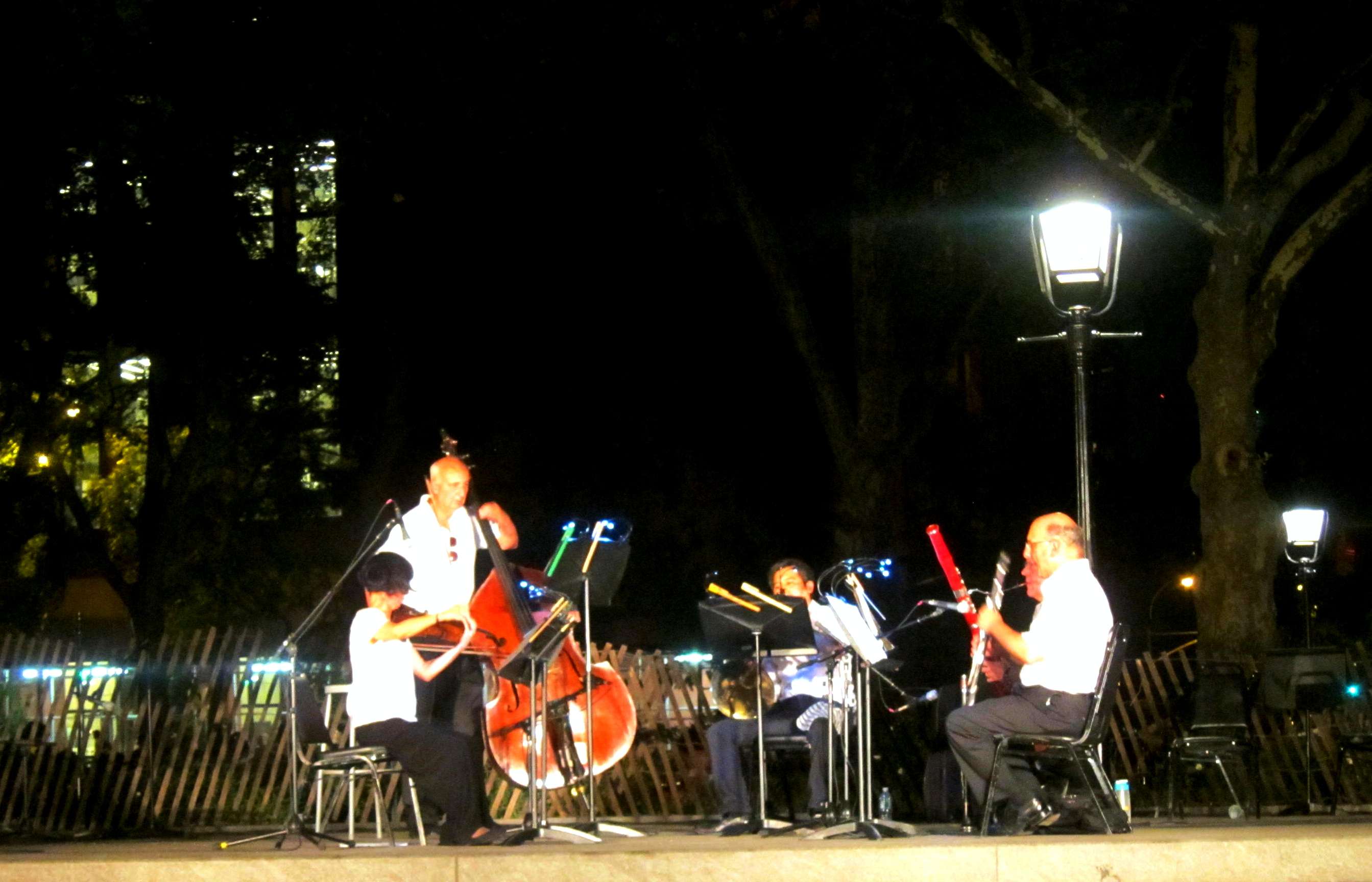|
Back
Eine (very very) kleine (literally) Nachtmusik New York
Washington Square Park
07/16/2013 -
“A Musical Adventure”
John Cage: Suite for Toy Piano
Phyllis Chen: Carousel – Cobwebbed Carousel
Jorge Torres Sáenz: Toy Symphony (American Premiere)
Jed Distler (with apologies to R. Wagner): Minute Ring
Michael Wookey: Coney Island Sous l’eau (World premiere chamber ensemble arrangement)
Adolphe Blanc: Septet, opus 40
Richard Strauss (arranged by Franz Hasenöhrl): Till Eulenspiegel: A Frolic for Five Instruments
Margaret Leng Tan (Toy piano, toy instruments)
Festival Chamber Ensemble: Steve Hartman, Pierre-Alain Giraud (Clarinets), Jason Sugota (French Horn), Harry Searing (Bassoon), Charles Kieger (Percussion and glockenspiel), Erica Sato Oei (Violin), Mario Gotoh (Viola), Latz Rath (Cello), Jeffrey Levine (Bass)

M. Leng Tan (© Coco T. Dog)
Several burlesque jokes have the same punch line. To wit, “But from this he makes a living?” Those unfamiliar with Margaret Leng Tan might have used that for “the queen of the toy piano.” Except that this classically trained pianist is also one of the most adept performers of avant-garde music, one of the keyboard preservers of John Cage’s legacy (he was her mentor for the last ten years of his life), and a concert performer of note.
Yet the international demand to play the toy piano (as she was last night in the second Washington Square concert of their 55th year), she obviously has made this her “brand”. Not only is she a virtuoso on this instrument (as well as the concert grand), but she has widened her repertory of toys to become a one-woman band.
Her instrument, though, is not our childhood’s idea of a toy piano. It still clicks and clucks after each note, the sounds are still more wooden than reverberating. But these toy pianos can have up to three octaves, and each piano makes a different sound. Thus, Ms. Tan played a pair of pianos with different sounds for a work by Michael Wookey, and she was able to pair the piano with a hand-cranked music box and other percussion in other works.
While several composers, like Rochberg and Kagel, have used the instrument at times, they are meant to blend in with an orchestra. John Cage wrote a solo suite though, and this unfortunately opened the program. Unfortunate since some in the outdoor audience thought she was tinkling for herself, and were all too anxious use their cellphones during the short work.
The piece is very much John Cage: simple, amusing, taking advantage of the percussive sounds. And it is short enough to be delightful. (Lou Harrison took a challenge and made an arrangement for huge orchestra, which is equally delightful.)
Following this Phyllis Chen’s two works about a carousel augmented the piano with a music box. The result was a pleasing tintinnabulation, though I had a sudden longing for a Mister Softee. No insult to the composer, but I kept thinking of the music of an ice cream cart.
The most ambitious solo work by far was a Toy Symphony by Jorge Torres Sáenz, five movements where Ms Tan competently balanced her toy piano, along with rattles, bells, bird-chirps (quite realistic, so one expected a Washington Square pigeon to come floating down), and other simulacra from field and stream. I found it daunting, inventive and not entirely satisfactory. Not until the final movement with the atrocious pun, “Toyccatina”–a toccata for toy piano.
Well, Ms. Tan’s training came in brilliantly here, where she ravished her instrument with a cadenza that could have been written by Ravel.
After this was a one-minute summation of Wagner’s Ring. Jed Distler probably wrote this with great humor, but Ms. Tan is neither a Victor Borge or an Anna Russell. Her distinct lack of humor, even with a bulky Valkyrie hat and Siegfried’s single line of German, was forced and frankly humorless. Ms. Tan, in her long long career, should really take a lesson or two from a comic actor.
By far, her most interesting music was Michael Wookey’s Coney Island Under the Sea, originally for two toy pianos and other toy instruments à la Leopold Mozart. But Mr. Wookey’s purpose was far more serious. He had seen the amusement park after our monstrous Sandy hurricane last year, with a result of bitter irony. The little orchestra and piano alternated merry–go-round carousel-style songs along with dissonances and atonal observations. A clever concept that was short, gave its message and left us with a strange sadness.

Festival Chamber Ensemble (© Coco T. Dog)
During the intermission, Ms. Leng Tan packed up her assemblage of whistles, birdcalls, tamtams, clappers, sticks and a dozen more anonymous sounds and furies, and left the second half to the Festival Chamber Ensemble. Their two works were most surprising.
The second was a Septet for Winds and Strings by one Adolphe Blanc, who lived less than 40 years, from 1828 to 1855. Wikipedia tells me he came from Alpes-de-Haute-Provence, and while he studied with Halévy, his music was not operatic at all, but restricted to chamber works.
Bassist Jeffrey Levine described him as the “bourgeois” composer of the evening, and that pretty well described his four-movement septet. It was certainly well made (with a delicious all too short tarantella and a cadenza beautifully played by violinist Eriko Sato Oei), the music was attractive in a Central European Central 19th Century manner, and it must have been a delight for the musicians to perform.
Mr. Blanc was the composer discovery of the evening. The piece to be discovered was Richard Strauss’s Till Eulenspiegel, “a frolic for five instruments.”
This was a weirdly truncated Till, (about half the length of the original), and while the important clarinet solos were gleefully played by Steve Hartman, the horn solos by Jason Sugota, the rest, with violin, contrabassoon, and bass. was almost a parody of the original. The original repetitions were cut, and the double-bass and contrabassoon took the place of percussion and snare drum at the final execution.
Rumor (and one of the musicians) thought that Strauss himself had arranged this under a pseudonym. That could be true, but likely, the arranger was one Franz Hasenöhrl, an Austrian who not only brought Strauss’s 100-piece orchestra to five, but–wisely–cut the timing down to about nine minutes.
What Herr Strauss thought of this is inconceivable (except that knowing a bit about Frau Strauss, as long as her husband got his percentage, she would be happy). If–like Ms. Leng Tan’s Minute Ring–the events of the story were hints and bagatelles, these five did manage to retain Strauss’s ghoulish humor along with a breezy happy performance.
Harry Rolnick
|